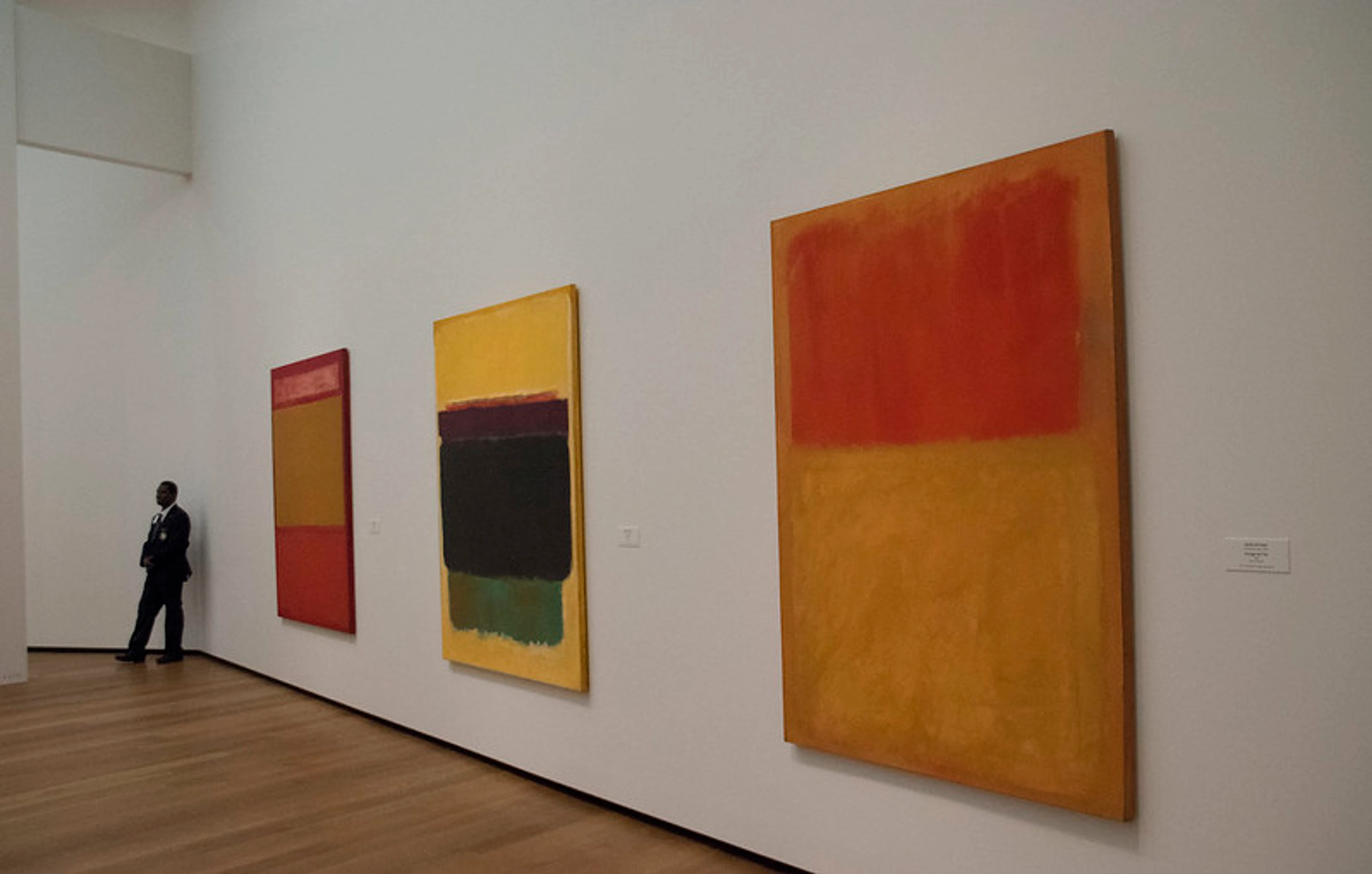
Abstract Expressionism: Ultimate Guide to Art, Artists & Feeling
Dive into Abstract Expressionism! Your ultimate, engaging guide to the artists (Pollock, Rothko), styles (Action/Color Field), history, techniques, and how to truly see it through a personal lens.
Abstract Expressionism: Your Ultimate Guide to Art That Feels (And Why It Matters)
You know that feeling when you see a painting, and it just hits you? Maybe it's chaos, maybe it's calm, maybe it's just a big splash of colour that makes zero logical sense but somehow speaks to a part of you that words can't quite reach. Chances are, you might have been looking at something influenced by, or directly part of, Abstract Expressionism. It's a movement that, for me, feels less like something to be understood intellectually and more like an experience to be felt viscerally. It taps into that raw, messy, beautiful stuff of being human.
It sounds a bit academic, doesn't it? "Abstract Expressionism." Like something you'd nod along to in a museum, pretending to understand. But honestly, it's one of the most human art movements out there. It threw out the rulebook of painting pretty pictures and decided to paint feelings, energy, the raw stuff of being alive in post-war America.
I remember the first time I really saw a Jackson Pollock, not just looked at it. It wasn't just drips; it felt like pure, unadulterated energy captured on canvas. Confusing? A little. Exciting? Absolutely. It made me think about my own process in the studio – those moments where the brush just moves, guided by something deeper than conscious thought. This guide is for anyone who's felt that flicker of confusion or excitement. We'll unpack what Abstract Expressionism is all about, who the key players were, the techniques they used, the world they lived in, and maybe, just maybe, help you understand why a canvas full of splatters or giant blocks of colour can be so incredibly powerful and compelling. Let's dive in.
What Is Abstract Expressionism (Really)?
Okay, let's break down the name. Abstract means it doesn't try to represent reality in a recognizable way. No landscapes you could hike through, no portraits that look exactly like Aunt Mildred. Expressionism means the focus is on conveying internal emotions and subjective experience rather than objective reality. Put them together, and you get Abstract Expressionism: art that uses abstract forms to express the artist's inner world. It's art that prioritizes the how and the why of feeling over the what of seeing.
Born primarily in New York City in the 1940s and flourishing in the 1950s, this wasn't just a style; it was a mood, a cultural moment. It was the first specifically American movement to achieve international influence, putting New York squarely at the center of the Western art world, a title previously held by Paris for, well, ages. Think of it as the artistic equivalent of jazz – improvisational, energetic, deeply personal, and undeniably American.
Key characteristics usually include:
- Monumental Scale: These paintings are often HUGE. They're meant to envelop you, to be an experience rather than just an object you glance at. This scale was partly influenced by the large public murals created during the WPA era, which provided many artists with work and a sense of community during the Depression, laying groundwork for the later scene.
- Emphasis on Spontaneity & Process: Many artists embraced automatism (letting the subconscious guide the hand, an idea borrowed from Surrealism but adapted for abstract ends) and improvisation. The act of painting itself became central. It wasn't just about the finished product, but the physical and emotional journey of creation.
- Emotional Intensity: Whether it's through chaotic gestures or vast, silent fields of colour, the aim is often to evoke strong feelings – anxiety, joy, despair, transcendence. It's art that aims for a direct, gut-level connection.
- Focus on the Artist's Psyche: The artwork was seen as a direct trace of the artist's inner state, their struggles, anxieties, and emotions. The self was the subject. This was deeply influenced by the post-war climate and the rise of existentialist thought.
It wasn't one single style, though. Think of it more like a big, messy, brilliant umbrella covering a range of approaches. We can broadly group these into two main streams...
The Two Big Streams (Because Art Loves Categories, Even When Artists Don't)
While the artists themselves often resisted neat labels (can't blame them, creativity is messy!), art historians tend to talk about two main tendencies within Abstract Expressionism:
1. Action Painting (The Energetic, Gestural Ones)
This is probably what most people think of first: the drips, the splashes, the wild gestures. Action Painting emphasizes the physical act of painting as an essential part of the finished work. The canvas becomes an arena where the artist acts out their emotions and impulses. It's less about depicting something and more about the doing, the performance, the trace left behind.
Think of Jackson Pollock literally dancing around his canvas on the floor, dripping and pouring paint. His technique, often called the "drip technique," wasn't random; it involved control, rhythm, and a deep engagement with the materials and gravity. It was a culmination of years of drawing and experimentation, a way to bypass conscious thought and tap directly into the subconscious. Or Willem de Kooning attacking his canvases with aggressive brushstrokes, building up and scraping away layers, often using thick impasto to create highly textured surfaces. His famous "Woman" series blurred the lines between abstraction and figuration, filled with raw, often jarring energy. It's less about a pre-planned image and more about capturing a moment of intense energy and process. It’s like watching a recording of a dynamic event, where the paint is the trace of that event.
I sometimes feel a similar (though much less historically significant!) energy when I'm working on a piece, letting the colours and strokes guide me rather than having a fixed plan. It's a risky way to work – sometimes it's magic, sometimes it's mud. You can see some explorations of this energy in contemporary abstract works.
2. Color Field Painting (The Soulful, Contemplative Ones)
Where Action Painting is about energy and gesture, Color Field Painting is about the emotional power of vast expanses of flat colour. These artists were less interested in the physical act and more focused on creating a contemplative, almost spiritual experience for the viewer through pure colour. They often used techniques like staining (pouring thinned paint onto unprimed canvas, as pioneered by Helen Frankenthaler) or applying thin layers of paint to allow the colour to soak into the canvas, making it feel like the colour is the canvas itself. This removed the artist's hand in a different way than Action Painting, focusing purely on the interaction of colour and surface.
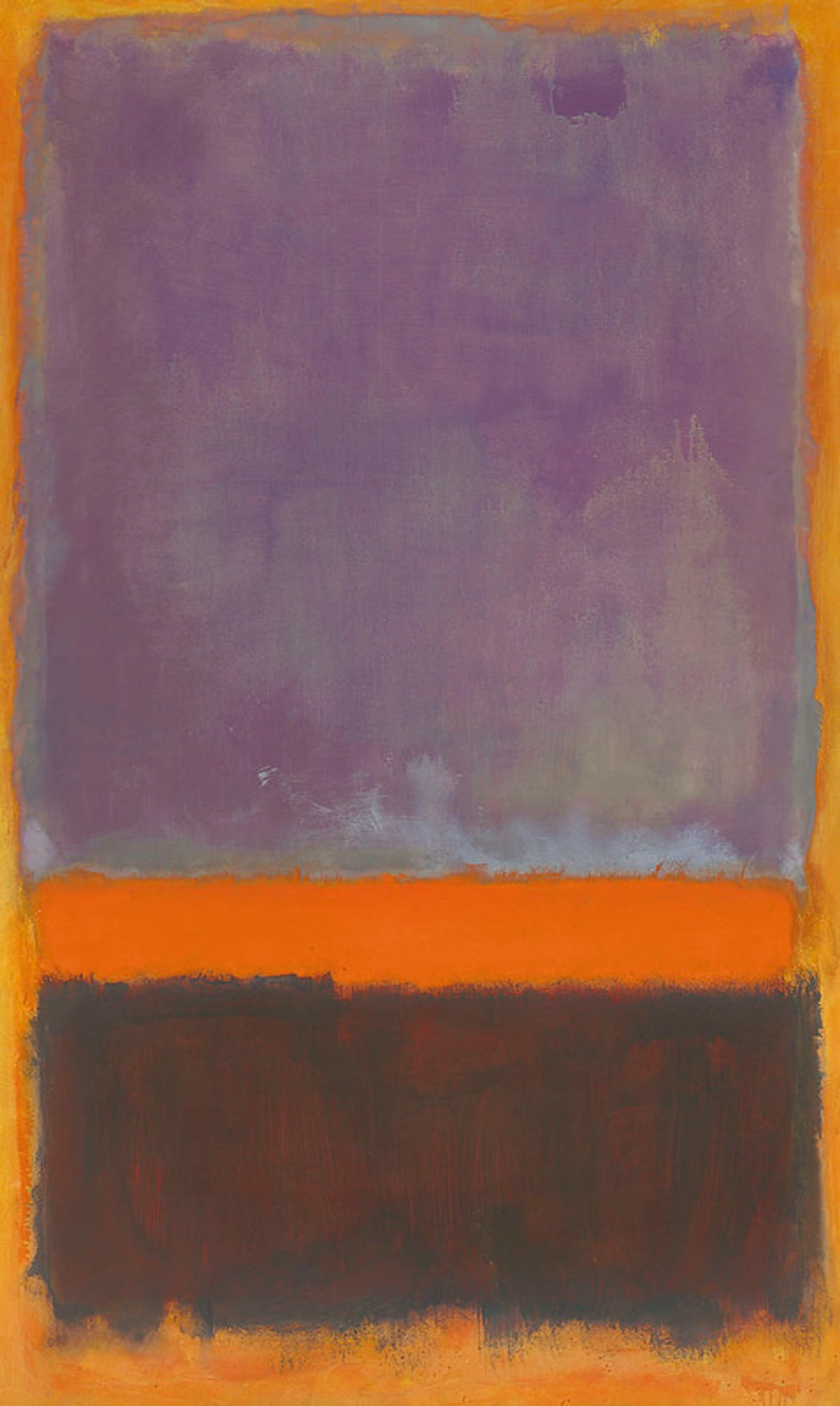
Think of Mark Rothko's signature fuzzy-edged rectangles hovering in fields of luminous colour. He wanted viewers to stand close, be enveloped, and have an almost religious experience. His work often aimed for the Sublime, evoking feelings of awe and transcendence. Or Barnett Newman's vast canvases punctuated by vertical lines he called "zips," dividing the space and creating a sense of scale and transcendence. His intellectual approach explored fundamental questions of existence through minimal means. Clyfford Still created jagged, craggy fields of colour, often using thick impasto, that feel elemental and raw, fiercely independent and tied to the American landscape.
These paintings demand a different kind of looking – slower, more meditative. They're not shouting; they're humming, resonating. If you want to dive deeper into this, our Ultimate Guide to Mark Rothko is a great place to start.
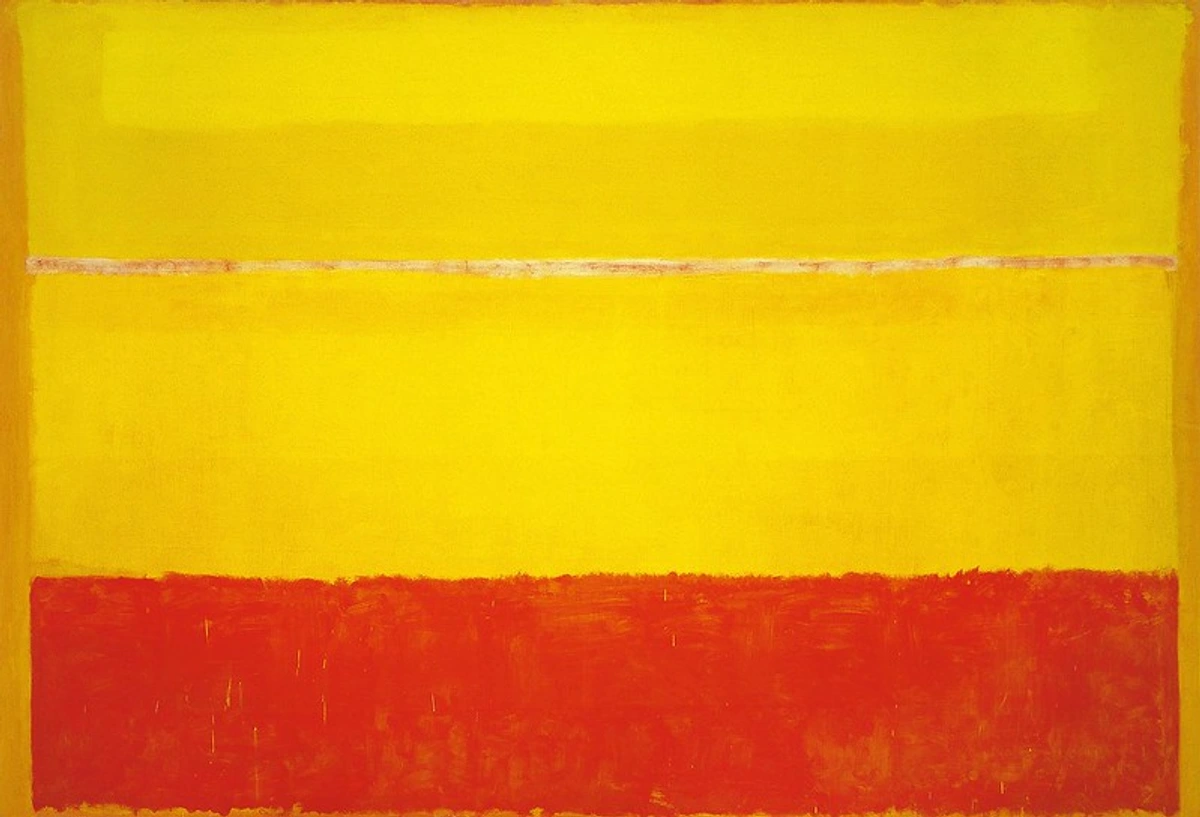
Historical Context: Why Then? Why There?
Abstract Expressionism didn't just appear out of thin air. It was forged in a specific time and place: New York City in the aftermath of World War II. It was a complex brew of global events, philosophical shifts, and a burgeoning American identity.
- Post-War Anxiety & Existentialism: The horrors of the war, the looming threat of the atomic bomb, and the rise of existentialist philosophy (Sartre, Camus) created a mood of anxiety, uncertainty, and a search for meaning in a seemingly absurd world. Many artists felt traditional art forms couldn't capture this new reality. They turned inward, seeking universal truths or raw expressions of the human condition. This search for meaning in chaos is palpable in the work.
- European Influence & the Shift to New York: Many European artists (like Max Ernst, André Masson, Piet Mondrian, Marcel Duchamp) fled to New York during the war, bringing ideas like Surrealism (especially automatism and accessing the unconscious) and Cubism's fragmentation of form with them. This created a fertile ground for cross-pollination and pushed American artists to engage with avant-garde ideas on their own terms. New York became a melting pot of artistic and intellectual energy, ready to take the lead from war-torn Paris.
- A Search for American Identity: There was a growing desire to create a distinctly American form of modern art, separate from European traditions. Abstract Expressionism, with its scale, energy, rugged individualism, and focus on the frontier-like canvas, fit the bill perfectly. It was seen as bold, direct, and uniquely American, sometimes even promoted internationally by the US government during the Cold War as a symbol of American freedom and creativity versus Soviet realism.
- The Rise of the New York Scene: Greenwich Village buzzed with galleries, bars (like the legendary Cedar Tavern, a key artist hangout), and intense intellectual debate. Galleries like the Betty Parsons Gallery and the Sidney Janis Gallery were crucial in showing and promoting these challenging new works. Influential critics like Clement Greenberg (who championed artists like Pollock and Newman, focusing on the formal qualities of painting) and Harold Rosenberg (who coined the term "Action Painting" and focused on the existential act of creation) championed the movement, helping to define its significance and propel it onto the international stage, sometimes controversially. Their differing perspectives shaped how the movement was understood.
This perfect storm of historical events, philosophical currents, and artistic exchange propelled Abstract Expressionism onto the world stage, shifting the focus of the art world from Paris to New York. You can explore more artistic shifts in our History of Art Guide.
Key Figures You Should Know (Or Pretend To, I Won't Tell)
While countless artists contributed, some names tower large in the Abstract Expressionist story. Knowing a few helps navigate the landscape. And it's important to remember that while the 'big names' are often male, women artists were absolutely central to the movement, pushing boundaries and developing key techniques. Despite facing significant gender bias in the male-dominated art world and critical establishment of the time, artists like Lee Krasner, Helen Frankenthaler, and Joan Mitchell made indispensable contributions that shaped the movement. Their work is increasingly recognized for its innovation and power.
Here's a quick look at some key figures:
Artist | Known For | Style | Quick Thought |
|---|---|---|---|
| Jackson Pollock | Drip paintings, energetic process | Action | The rockstar, famous for the how as much as the what. Pure energy on canvas. |
| Willem de Kooning | Aggressive brushwork, abstract "Woman" series | Action | Blurred the lines between abstract and figurative, intense and often jarring. Master of impasto. |
| Mark Rothko | Large, hovering rectangles of color | Color Field | Deeply spiritual, aimed for emotional resonance. Wanted you to feel enveloped. More here. |
| Barnett Newman | Vast color fields, "zips" (vertical lines) | Color Field | Intellectual and sublime, exploring scale and the void. His "zips" divide space and time. |
| Franz Kline | Bold, black-and-white architectural gestures | Action | Powerful, stark, like urban calligraphy on a massive scale. Felt monumental. |
| Clyfford Still | Jagged, craggy fields of impasto color | Color Field | Raw, elemental, fiercely independent. His colours feel like landscapes of the soul. |
| Robert Motherwell | Elegiac "Elegy to the Spanish Republic" series | Both | More lyrical and intellectual, often incorporated collage. A bridge between Europe and New York. |
| Lee Krasner | Varied abstract styles, collage, Pollock's wife | Action/Other | A powerful innovator, constantly reinventing her approach. Deserves more spotlight. |
| Helen Frankenthaler | Stain painting technique ("soak-stain") | Color Field | Poured thinned paint onto unprimed canvas, creating luminous, fluid forms. Pure colour soaking in. |
| Joan Mitchell | Energetic, colorful, landscape-inspired abstracts | Action | Kept the expressive gesture alive with vibrant, nature-rooted canvases. Her strokes sing. |
| Arshile Gorky | Biomorphic forms, precursor to AbEx | Other | Bridged Surrealism and AbEx, his fluid lines and forms influenced de Kooning and others. |
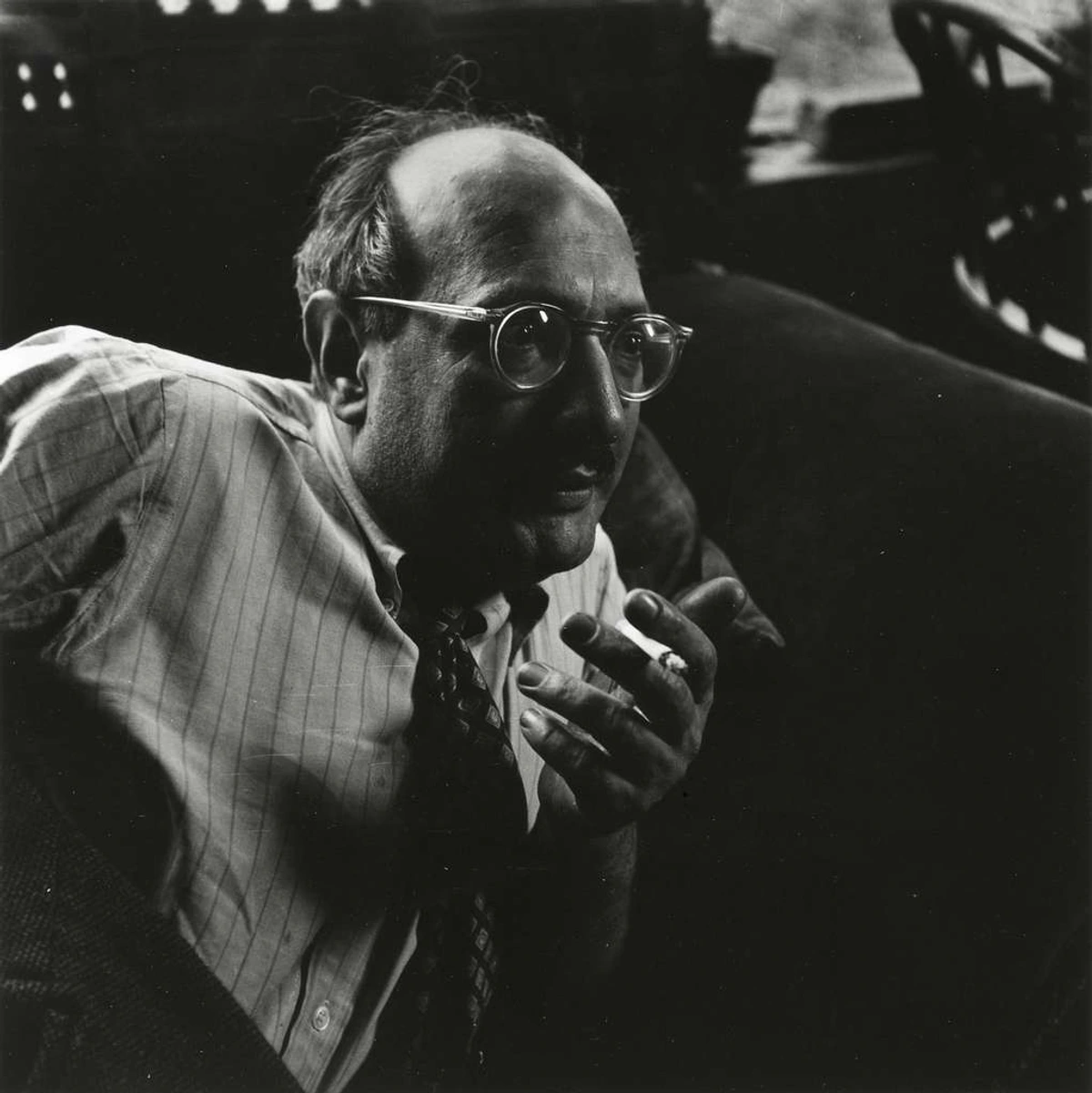
This is just a starting point, of course. Many other modern artists were part of this vibrant scene.
Core Ideas & Techniques (The Nitty-Gritty of Feeling)
Beyond the big names and broad styles, some core concepts and techniques were central to the Abstract Expressionist project. They weren't just throwing paint around; there was often a deep theoretical or philosophical drive behind the work.
- Automatism: As mentioned, letting the subconscious take over. Less thinking, more doing. It's about tapping into something primal, bypassing rational control. While borrowed from Surrealism's aim to access the unconscious mind for imagery, AbEx artists used it more to explore pure form, gesture, and the physical interaction with materials. Think of it like driving a familiar route – sometimes your hands just know what to do without conscious thought. Applying that to painting, but with raw emotion. Sounds relaxing, but probably quite stressful in practice if you're hoping for a masterpiece!
- All-Over Composition: Especially in Action Painting, the idea that the composition lacks a single focal point. Every part of the canvas holds equal importance, creating a continuous field of energy that extends beyond the edges. Think Pollock's drips extending edge to edge, challenging traditional Western composition with its hierarchies and central subjects. It forces your eye to keep moving, experiencing the whole surface.
- The Sublime: Particularly for Color Field painters like Rothko and Newman, an interest in evoking feelings of awe, vastness, and transcendence – experiences that overwhelm the senses and hint at something beyond the everyday. Standing before a giant Rothko can feel like this, a moment of quiet, overwhelming presence, a connection to something larger than yourself. This concept has roots in Romanticism but was reinterpreted through abstraction.
- Techniques Beyond the Brush: While brushes were used, AbEx artists often employed unconventional methods – pouring, dripping, staining, scraping with palette knives, using sticks or trowels. The emphasis was on the direct, physical engagement with the paint and canvas, making the process visible in the final work. Impasto (thick application of paint) was common, adding a sculptural quality to the surface and emphasizing the materiality of the paint itself. Staining, as pioneered by Frankenthaler, allowed colour to seep into the canvas, blurring the line between paint and support.
- Existential Concerns: A grappling with fundamental questions of existence, freedom, and meaning in a seemingly chaotic post-war world. Heavy stuff, but it fueled powerful art that sought to connect with universal human experience. Some artists, like Rothko and Newman, were also influenced by Carl Jung's ideas about the collective unconscious and archetypes, seeking to tap into universal symbols and emotions that resonate across humanity.
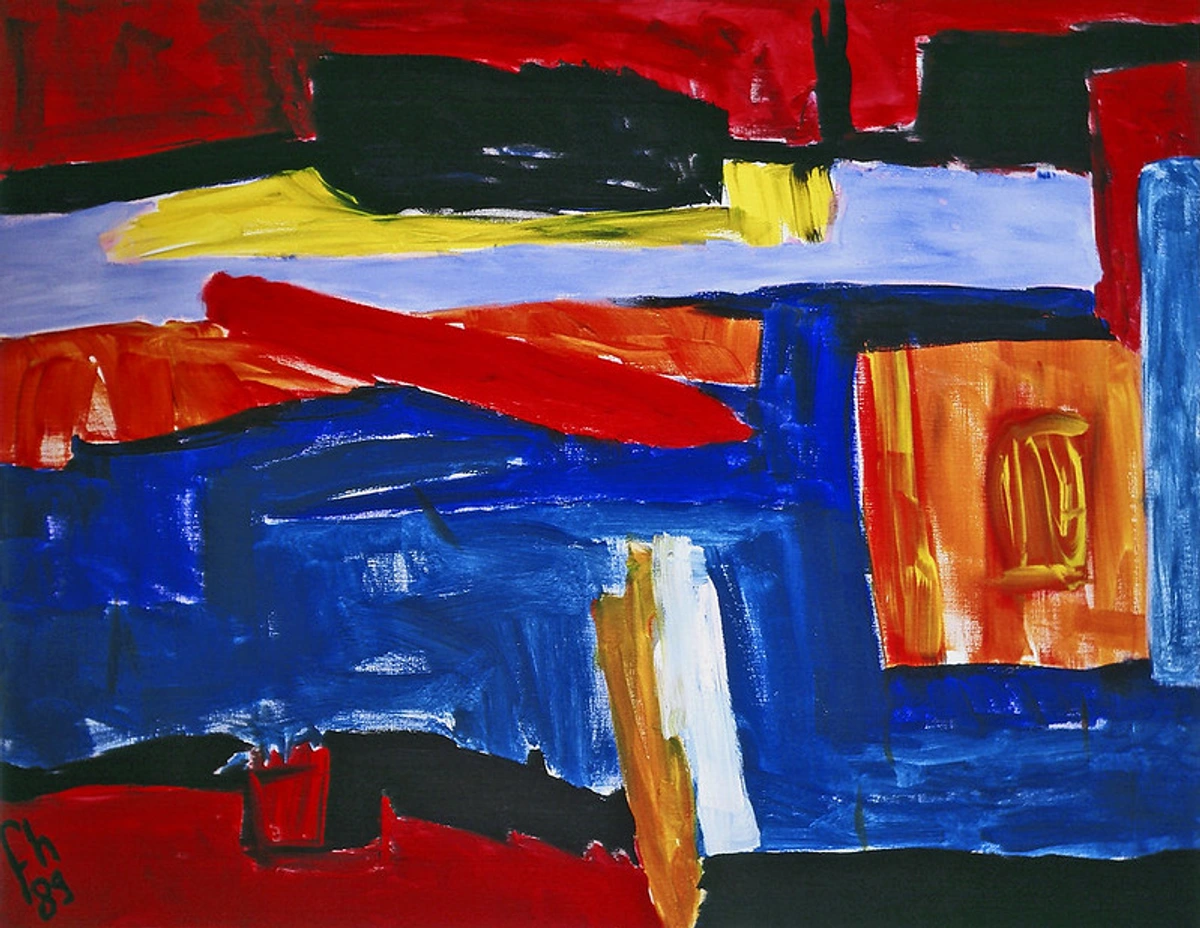
Controversies and Public Reception
Abstract Expressionism wasn't universally loved (is any groundbreaking art?). Its rise was met with confusion, ridicule, and sometimes outright hostility from a public accustomed to more traditional or even earlier forms of modern art. Critics debated its merits fiercely. Was it genius or fraud? Was it truly profound or just messy paint?
Part of the controversy stemmed from its radical departure from representation. For many, art had to depict something recognizable. The idea that drips or fields of colour could hold deep meaning was baffling or even offensive. The large scale also contributed – why waste so much canvas on that?
The movement's association with New York and its sudden rise to international prominence also ruffled feathers, particularly in Europe, which had long been the undisputed center of the art world. The perceived arrogance and commercial success of some artists, particularly Pollock's rise to celebrity status (fueled partly by media coverage and figures like Hans Namuth's films of him painting), added another layer of public fascination and skepticism. The art market also played a role, with rising prices making the work seem inaccessible or elitist to some.
Despite the backlash, or perhaps partly because of it, Abstract Expressionism captured the public imagination and forced a fundamental rethinking of what art could be.
Why Does It Matter? (Legacy & Influence)
Abstract Expressionism wasn't just a flash in the pan. It fundamentally changed the course of art history and continues to resonate today. Its impact was profound, both in what it created and in the reactions it provoked.
- Shifted the Art World: Cemented New York as the dominant center for contemporary art, a position it largely holds today. This geographical shift had massive implications for artists, galleries, and the global art market.
- Paved the Way: Its ideas about abstraction, process, scale, and the artist's role directly influenced subsequent movements, often through direct reaction. Pop Art, for instance, can be seen as a direct reaction against AbEx's perceived seriousness, introspection, and heroic individualism, turning instead to mass culture, irony, and commercial imagery (think Warhol's soup cans vs. Rothko's fields of colour). Minimalism took the focus on scale, pure form, and the objecthood of the canvas in a different direction, stripping away gesture, emotion, and the artist's visible hand (think Stella's geometric canvases vs. Pollock's drips). Conceptual Art built on the idea that the artist's idea or process could be the art itself, a concept certainly explored in Action Painting's emphasis on the act of creation.
- Redefined Painting: Expanded the definition of what painting could be – moving beyond representation to embrace pure form, colour, gesture, and the physical properties of paint. The canvas became an object, an environment, not just a window. It opened up possibilities for future generations of painters.
- The Artist as Celebrity: The public fascination with figures like Jackson Pollock helped create the modern image of the artist as a cultural icon, a trend that continues today with famous visual artists today.
- Enduring Appeal: Why do we still look? Maybe because that raw emotion, that search for meaning in chaos, still speaks to us. The energy, the quiet contemplation – these are timeless human experiences. AbEx reminds us that art can connect directly to our feelings, bypassing the need for recognizable imagery. You can see echoes of this search in many contemporary artists today. Exploring these historical roots certainly informs my own artistic journey.
Experiencing Abstract Expressionism (How to Look Without Panicking, Seriously)
Okay, you're standing in front of a giant canvas of what looks like... well, abstract stuff. How do you "get" it? Let's be honest, there's no single right way, and sometimes "getting it" isn't the point. It's okay if it feels like staring at a fancy wallpaper pattern initially – we've all been there. But here are a few tips, drawing from ideas in how to read a painting:
- Forget "What is it?": Instead, ask "How does it feel?" Let your emotional response guide you first. Is it chaotic, calm, angry, joyful, unsettling? Does the colour make you feel something specific? Trust your gut reaction.
- Notice the Physicality: How was the paint applied? Thick and textured (impasto)? Thin and stained? Dripped and poured? Can you sense the artist's movement, their energy? Look for the traces of the process. Imagine the artist in the studio – what were they doing?
- Embrace the Scale: If it's large, let it surround you. Step close (but not too close!), then step back. How does the feeling change with distance? Rothko, in particular, wanted viewers up close to be enveloped by the colour, almost as if entering a different space.
- Look at Composition: Even in abstraction, there's structure. Where do your eyes go? Are there dominant shapes or colours? Is there balance or tension? Is it an "all-over" composition with no single focal point, or does it have distinct zones? How does the artist guide your eye across the surface?
- Consider the Colour: What colours are used? Are they harmonious or clashing? Bright or muted? How do they interact? Color Field painters believed colour was the subject, capable of conveying profound emotion on its own. Think about how different colours make you feel.
- Read the Title (Sometimes): AbEx titles can be tricky – sometimes descriptive (Number 1A, 1948), sometimes evocative (Vir Heroicus Sublimis), sometimes just numbers. They aren't always a key to what it is, but they can offer a hint about the artist's mindset or the feeling they were exploring. Or sometimes, they seem deliberately obscure, adding to the enigma.
- Give it Time: These paintings often reveal themselves slowly. Don't just glance. Sit with it for a few minutes. Sometimes the initial "huh?" transforms into something deeper. It's okay if it doesn't click immediately – or ever! Art is subjective, and your reaction is valid. The goal isn't necessarily understanding, but experiencing.
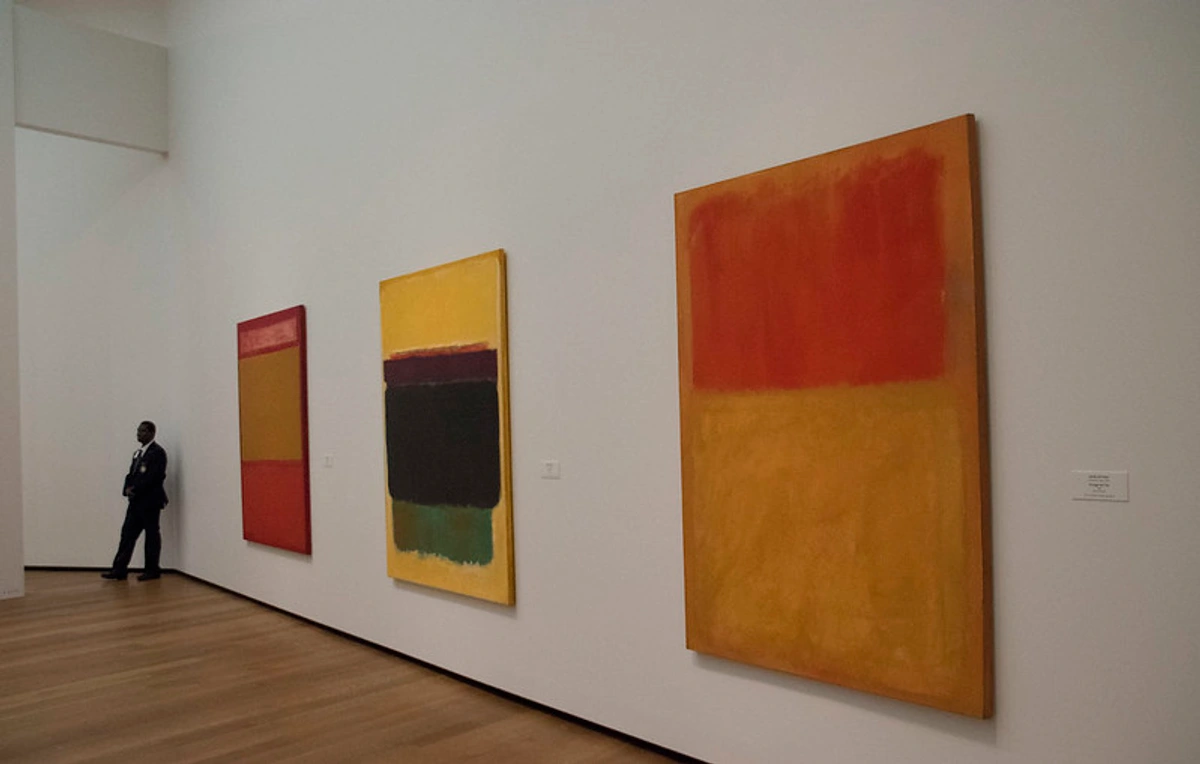
Common Misconceptions (Let's Clear the Air, With a Hint of Self-Deprecation)
- "My kid could paint that!" Ah, the classic. And honestly, sometimes I look at my own abstract work and think, "Yeah, maybe." But while some AbEx works look spontaneous, they often involved immense skill, control (Pollock's drips weren't random, they were the result of years of drawing and experimentation), and deep theoretical grounding. Plus, your kid probably wasn't revolutionizing the art world in post-war New York while grappling with existential dread. Context matters! And frankly, the idea and the impact are as much a part of the art as the execution.
- "It's just random mess." Often, there's an underlying structure, a deliberate exploration of materials, or a profound emotional or philosophical intent. "Random" rarely does it justice. It might be chaotic, but it's usually intentionally chaotic, or guided by subconscious impulses rather than pure chance.
- "All Abstract Expressionism looks the same." As we've seen, Action Painting and Color Field Painting are vastly different! Even within those categories, Kline's stark black and white is worlds away from de Kooning's fleshy chaos, or Frankenthaler's luminous stains. It's a broad church, united by underlying principles rather than a single visual style.
Where to See Abstract Expressionism Today
Want to experience these works in person? You're in luck. Major museums around the world have significant collections. Some key places include:
- The Museum of Modern Art (MoMA), New York: Holds iconic works by Pollock, de Kooning, Rothko, and many others. A must-visit for any AbEx enthusiast.
- The Whitney Museum of American Art, New York: Focuses on American art, with strong holdings of Abstract Expressionism.
- The Metropolitan Museum of Art, New York: Also has important examples within its vast collection.
- The Art Institute of Chicago: Features significant works by de Kooning, Pollock, and Gorky.
- Tate Modern, London: Houses major pieces by Rothko, Pollock, and Newman, among others.
- Centre Pompidou, Paris: Despite the shift away from Paris, this museum has a strong collection of American post-war art, including AbEx.
- National Gallery of Art, Washington, D.C.: Contains notable works by key figures.
Many other best museums for modern art and modern art galleries worldwide will feature Abstract Expressionist works in their collections or temporary exhibitions. Seeing them in person, feeling their scale and presence, is truly the best way to connect with this movement.
Frequently Asked Questions (FAQ)
Q: What is the main idea behind Abstract Expressionism? A: The core idea is using abstract (non-representational) means to express personal emotions, subconscious feelings, and universal human themes, often on a large scale and with a strong emphasis on the act of creation itself and the artist's inner state. It's about feeling and process over depiction.
Q: Who are the 3 most famous Abstract Expressionist artists? A: It's hard to pick just three, but Jackson Pollock, Willem de Kooning, and Mark Rothko are arguably the most famous and represent key aspects of the movement (Action Painting and Color Field).
Q: What is the difference between Action Painting and Color Field painting? A: Action Painting (e.g., Pollock, de Kooning) focuses on the physical act and gesture of painting, often resulting in energetic, textured surfaces that emphasize the process. Color Field Painting (e.g., Rothko, Newman, Frankenthaler) emphasizes large, flat areas of colour to create emotional or contemplative responses, focusing on the immersive power of colour itself and often minimizing the visible hand of the artist.
Q: When and where did Abstract Expressionism happen? A: It primarily emerged in New York City in the 1940s and reached its peak in the 1950s.
Q: Where can I see Abstract Expressionist art? A: Major museums worldwide have significant holdings, especially those focusing on modern and contemporary art. Key collections are found at MoMA (New York), the Whitney Museum (New York), the Art Institute of Chicago, Tate Modern (London), and the Centre Pompidou (Paris), among others. Check out our guide to the best museums globally.
So, What's the Takeaway?
Abstract Expressionism can seem intimidating, maybe even a bit pretentious from the outside. But at its heart, it's about stripping away the familiar and diving straight into feeling, energy, and the big, messy questions of existence. It's about the courage to put raw emotion onto a canvas, whether through a frantic dance of drips or a silent, vibrating field of red. It's about the artist's internal landscape made visible.
It might not always be pretty, and it definitely won't always make sense in a logical way. But next time you encounter one of these works, try letting go of the need to "understand" it like a puzzle. Instead, let yourself feel it. See where it takes you. You might be surprised by the connection you find, a resonance with that raw human experience the artists were trying to capture. And who knows, it might even inspire you to explore the abstract art available today, carrying that legacy forward in your own space.




